علاج اصبع القدم المطرقية جراحياً في تركيا على يد أفضل أختصاصيي الجراحة العظمية.
حيث يمكن أن يسبب هذا التشوه ألمًا وصعوبة في المشي، وقد يظهر مسمار فوق المفصل.
أما تصلب المفاصل، والألم في الجزء العلوي من إصبع القدم المنحني، والتورم فهي بعض أعراض أصابع القدم المطرقية. وهذه الحالة مشابه للإصبع الزنادي في اليد.
إذا كانت لديك هذه أعراض، فاستشر طبيب جراحة الأطراف في أسرع وقت ممكن. حيث يمكن علاجها جراحياً في تركيا على يد أفضل أختصاصيي الجراحة العظمية.
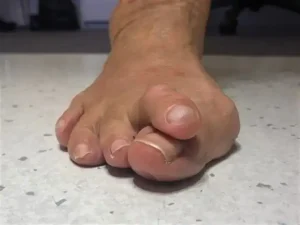
ما هي أصابع القدم المطرقية؟ كيف تبدو؟
أصابع القدم المطرقية “Hammertoes” هو مصطلح يشير إلى تغيرات المفاصل التي تشمل إصبعًا أو أكثر من أصابع القدم.
حيث يصبح شكل الأصبع مشابه للمطرقة حيث يكون إصبع القدم متجه إلى أعلى بدلاً من الاستلقاء بشكل مسطح.
يحدث هذا التشوه لأن عضلات القدم أو الساق تضعف وتسحب الأوتار رأس إصبع القدم بشكل غير طبيعي.
قد يكون هناك أيضًا مسمارًا فوق إصبع القدم المشوه، والذي قد يكون مؤلمًا. كما قد يكون من الصعب تحريك إصبع القدم المصاب.
ما الفرق بين الأصابع المطرقية، وأصابع القدم المطرقية، وأصابع المخالب؟
كل قدم من قدميك بها 28 عظمة. من بين أصابعك الخمسة، يحتوي الإصبع الأول (أو “إصبع القدم الكبير”) على مفصلين: المفصل المشطي السلامي والمفصل السلامي. تحتوي الأربعة الأخرى على ثلاثة مفاصل: عند قاعدة إصبع قدمك يوجد المفصل المشطي السلامي (المفصل الأول)، وفي المنتصف يوجد المفصل السلامي القريب (المفصل الثاني) والأقرب إلى الطرف أو الظفر هو المفصل السلامي البعيد (المفصل الثالث).
أحيانًا يتم خلط بين أصابع القدم المطرقية (Hammertoes) بالأصابع المطرقية (mallet toes) وأصابع المخالب (Clawtoes). ولكن هناك اختلافات بينهما:
أصابع المخالب (Clawtoes): هي الانحناء في مفاصل إصبع القدم الأول والثاني.
أصابع القدم المطرقية (Hammertoes): يكون الانحناء في مفصل إصبع القدم الثاني (أو الأوسط).
أصابع المطرقية (mallet toes): الانحناء في مفصل إصبع القدم الثالث.
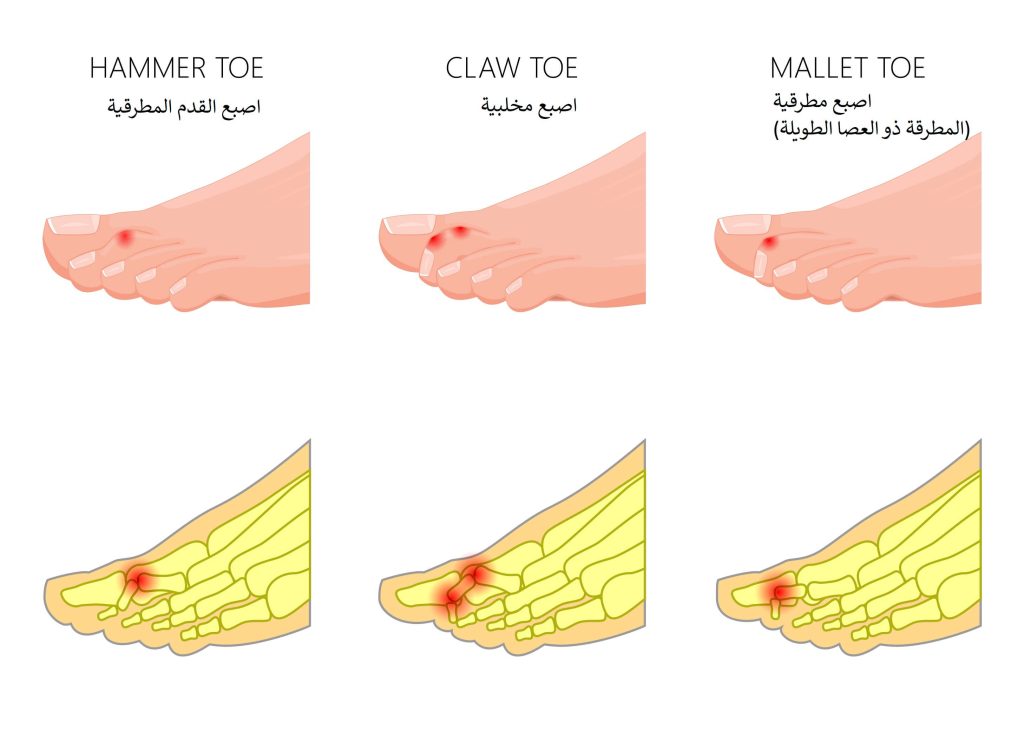
ما هي أنواع أصابع القدم المطرقية؟
هناك ثلاثة أنواع من أصابع القدم المطرقية:
- أصابع مطرقية مرنة: يكون لا يزال إصبع القدم المطرقية المرن في طور النمو، لذلك لا تزال أصابع القدم المصابة قادرة على التحرك عند المفصل.
- شبه صلب: يكون قد بدأ إصبع القدم المطرقية في التصلب.
- أصابع مطرقية صلبة: هنا لا يعود بالإمكان للمطرقة الجامدة أن تتحرك بسبب شد الأوتار والأنسجة الرخوة.
من المحتمل أن يصاب بأصابع القدم المطرقية؟
أولئك الذين يرتدون الكعب العالي والأحذية غير الداعمة هم أكثر عرضة للإصابة بأصابع القدم المطرقية.
هل تؤلم اصبع القدم المطرقية؟
قد تتسبب محاولة تحريك المفصل في الشعور بالألم وقد تشعر بألم في باطن قدمك.
كما يمكن أن تكون مسامير اللحم والدُشبذات أيضًا غير مريحة.
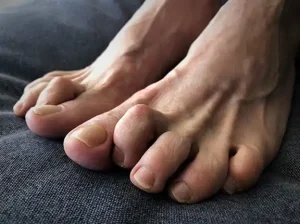
هل المطرقة هي نفس الأورام؟
لا، الورم هو نتوء يتشكل على الجزء الخارجي من إصبع قدمك الكبير.
هل يمكن أن تسبب المطرقة الخدر؟
ليس هناك ارتباط مباشر بين إصبع القدم المطرقية والخدر.
أعراض وأسباب اصبع القدم المطرقية
ما الذي يسبب إصابات اصبع القدم المطرقية؟
يمكن أن يؤدي التوازن غير الطبيعي للعضلات في إصبع قدمك إلى زيادة الضغط على الأوتار والمفاصل، مما يتسبب في حدوث إصبع القدم المطرقية. وتشمل أسباب هذا الخلل العضلي ما يلي:
- الجينات: نوع القدم الذي ولدت به قد يؤهلك لتطوير هذا النوع من تشوه المفاصل. يمكن أن تؤدي الأقدام المسطحة والمرنة إلى أصابع مطرقية حيث تحاول القدم الاستقرار مقابل قوس مسطح. يمكن أن تشكل الأقدام ذات الأقواس العالية أيضًا أصابع مطرقية حيث تغلب الأوتار الباسطة على الثنيات.
- الأحذية الرديئة: الأحذية الضيقة جدًا وغير الملائمة، مثل الكعب العالي، لها دعامة قليلة أو معدومة. يضع الكعب العالي ضغطًا شديدًا على أصابع القدم ومفاصلها. لهذا السبب تم العثور على المزيد من حالات إصبع القدم المطرقة لدى النساء أكثر من الرجال.
- الأمراض العصبية العضلية: يمكن أن تساهم الأمراض العصبية العضلية في تطور إصبع القدم المطرقة. يمكن أن يكون الأشخاص المصابون بداء السكري أكثر عرضة للإصابة بالمضاعفات. بالنسبة لهم، يشير إصبع القدم المصحوب بالذرة أو أي تقرح آخر إلى وجود ضغط كبير على أصابع القدم. في مرضى السكري الذين يعانون من ضعف تدفق الدم أو الاعتلال العصبي، يمكن أن تؤدي مسامير اللحم المصابة والآفات إلى فقدان إصبع القدم أو القدم ما لم يتم تعديل أحذيتهم.
- الصدمة: نادرًا ما تؤدي إصابة إصبع قدمك إلى إصبع القدم المطرقة.
ما هي أعراض أصابع القدم المطرقية؟
تشمل أعراض إصبع القدم المطرقية ما يلي:
- مفصل في إصبع قدمك يصبح صلبًا.
- ألم – عادة في الجزء العلوي من إصبعك المنحني.
- ألم في كرة قدمك.
- مسامير اللحم والدُشبذات في الجزء العلوي من مفصلك.
- احمرار أو التهاب أو حرقان.
- حركة مقيدة أو مؤلمة لمفصل إصبع قدمك.
- تورم في مفصلك.
- القروح المفتوحة (نادرة).
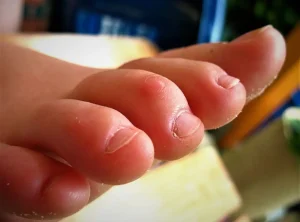
ما الذي يجعل إصبع القدم المطرقية أسوأ؟
يمكن أن تزيد الأحذية إصبع القدم المطرقية (Hammertoes) سوءًا بمرور الوقت، خاصةً مع الأحذية غير الداعمة وضيقة الأوتار.
التشخيص والاختبارات
كيف يتم تشخيص أصابع القدم المطرقية؟
قد يتعرف طبيبك المعتاد على إصبع القدم المطرقية على الفور. وقد يُرسلك أيضًا إلى اختصاصي الأقدام، أو جراح القدم والكاحل، للحصول على تشخيص دقيق. سيقوم الطبيب بإجراء فحص جسدي بما في ذلك لمس وتحريك قدمك وأصابع قدمك لمعرفة كيفية تفاعل المفاصل. وقد تحتاج أصابع قدميك إلى الأشعة السينية.
إذا كنت مصابًا بداء السكري، فقد تضطر إلى الخضوع لاختبارات لمعرفة ما إذا كانت هناك حالة عصبية تسبب خللًا في الأوتار أم لا.
الإدارة والعلاج لإصبع القدم المطرقية في تركيا
كيف يتم علاج أصابع القدم المطرقية؟ كيف يتم تصحيحها؟
تشمل علاجات أصابع القدم المطرقية ما يلي:
- الجراحة: قد يوصي طبيبك بإجراء عملية جراحية إذا كان الألم شديدًا، وإذا كان إصبعك المطرقي يشكل عائقا لأنشطتك اليومية و/ أو لم تساعد العلاجات غير الجراحية في حل المشكلة.
أثناء الجراحة، قد يزيل الجراح البروز العظمي من إصبع قدمك ويقوم بمحاذاة المفصل، أو يُدخل دبوسًا فولاذيًا لتصحيح موضع إصبع قدمك. - إدخالات الأحذية المخصصة / أجهزة تقويم العظام: يمكنها التحكم في كيفية عمل قدمك.
- تخفيف الآلام: تناول الأدوية المضادة للالتهابات أو أخذ حقن الكورتيزون لتخفيف الألم.
- ربط أصابع قدميك: هذا يمكن أن يغير اختلال التوازن العضلي.
- الحشو العازل: يمكن أن يقلل الحشو حول إصبع القدم المطرقية من الضغط.
ما هي مخاطر جراحة اصبع القدم المطرقية في تركيا؟
تشمل مخاطر الجراحة ما يلي:
- العدوى.
- نزيف.
- إصابة العصب.
- الكزاز.
هل بعد الجراحة سيتم تخريجي من المشفى؟
في العيادات الخاصة، لن تقضي الليلة في المستشفى.
كم من الوقت يستغرق التعافي من الجراحة؟
قد تشعر بتصلب ورؤية بعض التورم والاحمرار لمدة أربعة إلى ستة أسابيع.
ماذا علي أن أفعل أثناء فترة التعافي من جراحة أصابع القدم المطرقية؟
لا تستخدم أصابع قدميك كثيرًا أثناء فترة الشفاء. وحافظ على رفع قدمك.
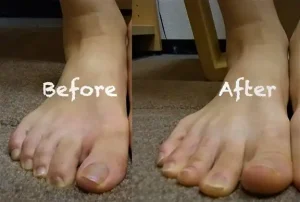
الوقاية من اصبع القدم المطرقية (عظمة القدم البارزة)
هل يمكن منع أصابع القدم المطرقية؟ كيف يمكنني تقليل المخاطر الخاصة بي؟
- ارتدِ أحذية مناسبة: إذا كنت لا ترغب في الخضوع لعملية جراحية لإصلاح إصبعك المطرقي، فجرّب الحشوة غير العلاجية جنبًا إلى جنب مع الأحذية المناسبة الأوسع والأعمق لتلائم شكل قدمك. يمكن للحذاء الجيد أن يبطئ تقدم الحالة.
- استخدم حجر الخفاف: يمكن أن يسبب مسمار القدم الذي يتشكل أعلى إصبع القدم المطرقية عدم الراحة عند ارتداء الأحذية. استخدم مبردًا أو حجر خفاف بعد حمام دافئ لتقليل حجم مسمار القدم. ثم قم بتطبيق المرطبات للحفاظ على المنطقة ناعمة ومرنة. استخدم حشوة السيليكون أو جلد الخلد فوق المنطقة عند ارتداء الأحذية.
- قم بتمارين القدم: يمكن لطبيب الأرجل أن يقترح تمارين لأصابع قدمك لإبقائها مرنة وتقوية العضلات التي تحركها. وقد يساعد تمديد أصابع القدم، ثم لفها، ورشها وتحريكها بشكل فردي، في منع التقلص الذي يسبب إصبع القدم المطرقة.
- اطلب من مقدم الرعاية الصحية الخاص بك إحالتك إلى أخصائي أقدام (طبيب متخصص في القدم) إذا بدأت في رؤية أو الشعور بأي مشكلة.
نظرة مستقبلية حول علاج اصبع القدم المطرقية
هل ستؤثر أصابع القدم المطرقية على المشي؟
يمكن أن يؤدي تشوه المفصل ومسامير اللحم إلى الشعور بالألم وبالتالي يمكن أن يحد من نشاطك.
ماذا علي أن أفعل أثناء التعافي من جراحة أصابع القدم المطرقية في تركيا؟
لا تستخدم أصابع قدميك كثيرًا أثناء فترة الشفاء. وحافظ على رفع قدمك.
كم من الوقت سوف يكون لدي أصابع مطرقة؟ هل هم دائمون؟
يمكن أن تزداد العواقب سوءًا بشكل تدريجي دون علاج، وبذلك ستكون دائمًا موجودة.
هل يمكن لأصابع القدم المطرقية أن تختفي؟
لا تتلاشى عوارض أصابع القدم المطرقية دون علاج. لذلك قم بمراجعة مقدم الرعاية الصحية الخاص بك بمجرد ملاحظة الأعراض.
العيش مع اصبع القدم المطرقية
كيف أعتني بأصابع القدم المطرقية؟ هل توجد علاجات منزلية؟
على الرغم من أنه لا يوجد شيء يجب أن يحل محل خبرة أخصائي الأقدام، إلا انه يمكنك تجربة ما يلي لتقليل الانزعاج:
- قلل الضغط على المنطقة عن طريق وضع ضمادة على شكل إصبع مطرق.
- ارتدِ أحذية ذات مجال واسع للأصابع.
- تجنبي الكعب الذي يزيد طوله عن بوصتين.
- ضع كيس ثلج إذا كان هناك تورم.
- ارتدِ أحذية فضفاضة.
كيف يبدو العيش مع أصابع القدم المطرقية؟
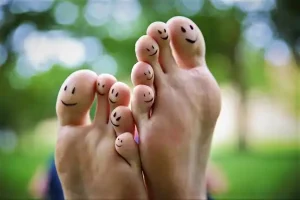
يعاني الأشخاص المصابون بالمطرقة من المشي والجري. ويحصلون على مسامير على إصبع قدمهم المشوه.
كيف يمكنني الاعتناء بقدمي؟
اعتني بقدميك من خلال ارتداء أحذية أطول بمقدار نصف بوصة من أطول إصبع في قدمك.
تجنب الأحذية الضيقة، وخاصة الأحذية ذات الكعب العالي.
في حال زيارتي للطبيب ما هي الأسئلة التي يجب أن أطرحها عليه؟
- هل هذا التشوه المفصلي هو إصبع مطرقة أم مخلب أم إصبع مطرقية؟
- ما نوع المطرقة التي أمتلكها؟
- ما هو سبب إصبع القدم المطرقية؟
- ما نوع العلاج الذي أحتاجه؟
- هل هناك أي علاجات منزلية يمكنني تجربتها؟
- هل يمكنك أن تنصحني بأي حذاء؟ أو هل هناك أحذية يجب علي تجنبها؟








